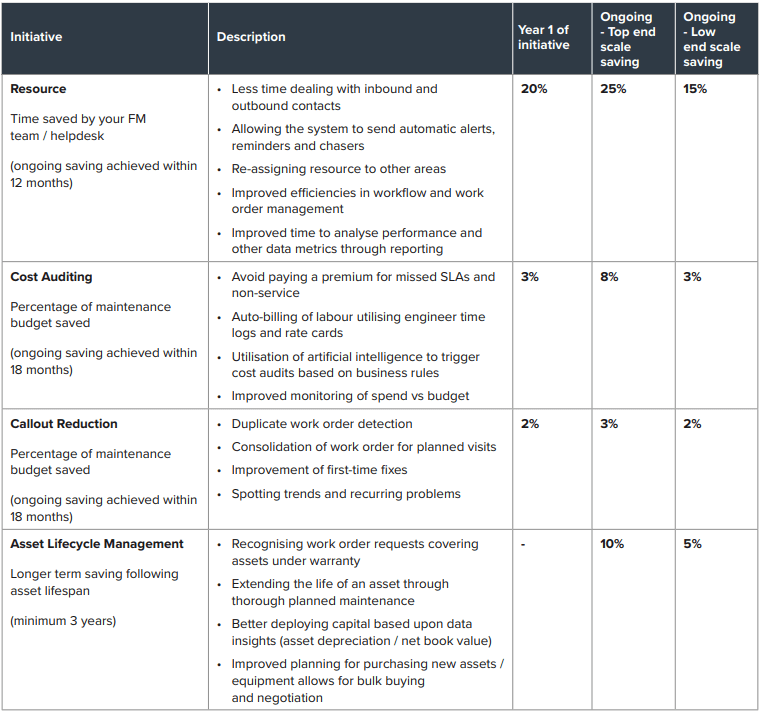A business case for a CAFM system needs to include some convincing ROI calculations if it’s going to persuade the C-Suite to release budget. But how do you present the best, and most credible, cost saving projections within your proposal?
What are the 5 essential parts of a FM business case?
A powerful Facilities Management business case contains five essential elements:
- Makes clear the FM challenges faced by your organisation
- Links investment in the solution with your organisation’s overall strategy
- Presents the risks of ‘doing nothing’ to the C-Suite
- Shows the way an FM software solution will mitigate them
- Shows expected savings and ROI following installation of the solution
Which part of the business case are you struggling with?
Of all of the challenges involved in creating a business case document, calculating and presenting the expected return on investment from a solution is the hardest for FM.
But including the calculations in your presentation can be vital to unlocking the budget you need, so it’s worth going the extra mile to gather the data.
Why is it so hard to present persuasive ROI calculations?
1. Lack of available data
Right now, you may simply be unaware exactly how much time and money you are wasting in certain areas. And this lack of data may be one of the reasons why you need to implement a CAFM system in the first place!
For example, if you’ve had no systematic way of tracking the lifecycle and maintenance spend on specific fixed assets, you might not be able to calculate internally how much you could save over time by elongating their life span and controlling Capex spend in the future.
For this calculation you might need to work with your FM software provider to see the savings companies of your size in your sector could typically expect.
On the other hand, there may be other areas where you can make more accurate calculations based on your own data.
You can see first hand, in your own call centre, how much time you are spending triaging and filtering initial work requests, turning them into work orders, sourcing quotes and organising engineer visits. Once you have that detail you can work out how much time and resource you could save through automation.
It should also be possible to retrospectively work out your current first time fix rate based on your records of repeat calls out, even if you’re not formally capturing this data as you go along. Equipped with this detail, you can project potential savings more soundly.
By digging through emails, talking to your call centre team, engineers and contractors you could come up with convincing estimates for the time and money you could save in one or all of the following areas:
- Improved efficiencies in workflows
- Duplicate work order detection
- Consolidation of work order for planned visits
- Improvement of first-time fix rate
Whether you’re working with a FM team or a CAFM partner, putting a figure next to a line item in your wish list will make the business benefits concrete for the C-Suite. Ultimately, it will make it more likely that you’ll win your funding.
2. Savings are all long term - you need to plan for faster results
The savings you are projecting might all be in the long term (way beyond the first year).
Return on investment on facilities management software can really be a slow burn, particularly if the implementation and training period for a new installation is lengthy.
One strategy that could help, though, is to work on an implementation that prioritises ‘easy wins’.
We all know the failure rate of complex, digital transformation projects is high - famously as much as 75% for big software implementations. But as Forbes writer Steve Andriole points out:
When it comes to big tech project management – given the failure rates – everyone should learn how to dance in small steps, not large ones. Resist the Tango for the Waltz.
A staggered implementation, in contrast with a delayed, ‘big bang’ release (where every feature of a CAFM is launched all at once) can help secure quicker returns, as well as internal momentum and enthusiasm for a project.
In this spirit, you might look at sorting work order automation first as call centre efficiencies will be felt more immediately on the bottom line, rather than waiting for the slow burn of improved procurement decisions from a digitised Asset Register.
This kind of planning will help you show the best possible financial business case to the C-Suite from the outset.
In the same way, splitting all your ROI calculations into first year savings and then demonstrating ongoing cost reductions in future years will help the C-Suite understand the timescales and incremental benefits you may feel in the long term following the initial outlay.
What’s the ROI for your CAFM implementation?
Calculating your exact return on investment from a CAFM system is always going to be complicated, but by working with your partners and digging deep into the available data you can present realistic figures that will help you win the budget you need.
Some examples of the varying factors you need to consider when calculating an ROI include:
- The current processes, systems and data you already have in place
(What’s your starting point and size of the prize?) - The size of your team and administration involvement
(In order to calculate where the system can save you time) - Size of your supply chain
(To calculate how spread out the work requests are) - Volume of work orders
(To calculate how you can reduce your callouts) - Whether an Asset register is already in place
(To understand whether you’re starting from scratch and the time to value)
To help you get started we’ve projected the range of savings a company might see from implementing the different elements of a CAFM system.
You’ll need to work with your FM supplier and use your own business data, budgets and resources to calculate what your FM digital transformation could be worth to you.
Below is an example of what you could expect:

.png?width=680&height=700&name=Ai%20page%20module%20(2).png)



